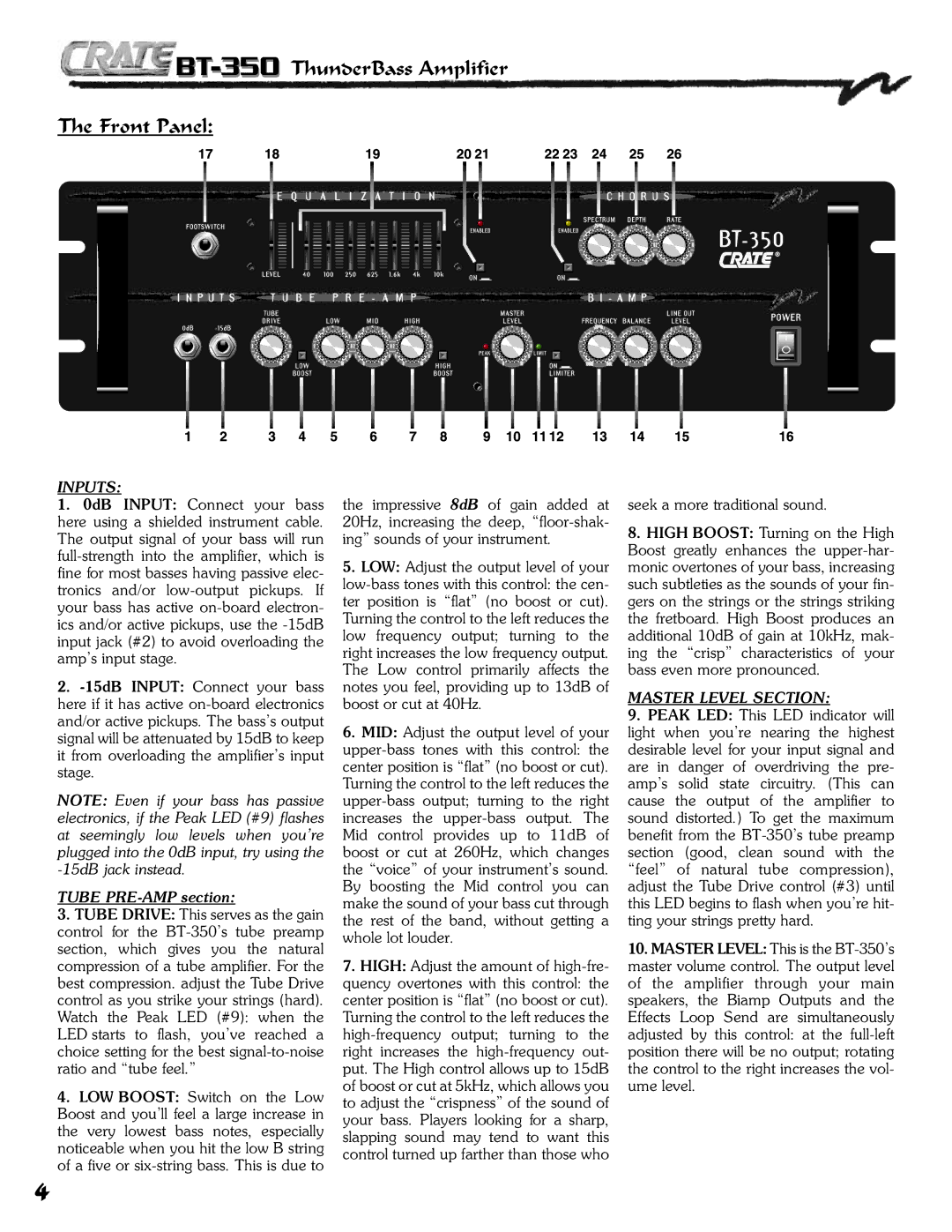INPUTS:
1.0dB INPUT: Connect your bass here using a shielded instrument cable. The output signal of your bass will run full-strength into the amplifier, which is fine for most basses having passive elec- tronics and/or low-output pickups. If your bass has active on-board electron- ics and/or active pickups, use the -15dB input jack (#2) to avoid overloading the amp’s input stage.
2.-15dB INPUT: Connect your bass here if it has active on-board electronics and/or active pickups. The bass’s output signal will be attenuated by 15dB to keep it from overloading the amplifier’s input stage.
NOTE: Even if your bass has passive electronics, if the Peak LED (#9) flashes at seemingly low levels when you’re plugged into the 0dB input, try using the -15dB jack instead.
TUBE PRE-AMP section:
3.TUBE DRIVE: This serves as the gain control for the BT-350’s tube preamp section, which gives you the natural compression of a tube amplifier. For the best compression. adjust the Tube Drive control as you strike your strings (hard). Watch the Peak LED (#9): when the LED starts to flash, you’ve reached a choice setting for the best signal-to-noise ratio and “tube feel.”
4.LOW BOOST: Switch on the Low Boost and you’ll feel a large increase in the very lowest bass notes, especially noticeable when you hit the low B string of a five or six-string bass. This is due to
the impressive 8dB of gain added at 20Hz, increasing the deep, “floor-shak- ing” sounds of your instrument.
5.LOW: Adjust the output level of your low-bass tones with this control: the cen- ter position is “flat” (no boost or cut). Turning the control to the left reduces the low frequency output; turning to the right increases the low frequency output. The Low control primarily affects the notes you feel, providing up to 13dB of boost or cut at 40Hz.
6.MID: Adjust the output level of your upper-bass tones with this control: the center position is “flat” (no boost or cut). Turning the control to the left reduces the upper-bass output; turning to the right increases the upper-bass output. The Mid control provides up to 11dB of boost or cut at 260Hz, which changes the “voice” of your instrument’s sound. By boosting the Mid control you can make the sound of your bass cut through the rest of the band, without getting a whole lot louder.
7.HIGH: Adjust the amount of high-fre- quency overtones with this control: the center position is “flat” (no boost or cut). Turning the control to the left reduces the high-frequency output; turning to the right increases the high-frequency out- put. The High control allows up to 15dB of boost or cut at 5kHz, which allows you to adjust the “crispness” of the sound of your bass. Players looking for a sharp, slapping sound may tend to want this control turned up farther than those who
seek a more traditional sound.
8.HIGH BOOST: Turning on the High Boost greatly enhances the upper-har- monic overtones of your bass, increasing such subtleties as the sounds of your fin- gers on the strings or the strings striking the fretboard. High Boost produces an additional 10dB of gain at 10kHz, mak- ing the “crisp” characteristics of your bass even more pronounced.
MASTER LEVEL SECTION:
9.PEAK LED: This LED indicator will light when you’re nearing the highest desirable level for your input signal and are in danger of overdriving the pre- amp’s solid state circuitry. (This can cause the output of the amplifier to sound distorted.) To get the maximum benefit from the BT-350’s tube preamp section (good, clean sound with the “feel” of natural tube compression), adjust the Tube Drive control (#3) until this LED begins to flash when you’re hit- ting your strings pretty hard.
10.MASTER LEVEL: This is the BT-350’s master volume control. The output level of the amplifier through your main speakers, the Biamp Outputs and the Effects Loop Send are simultaneously adjusted by this control: at the full-left position there will be no output; rotating the control to the right increases the vol- ume level.

